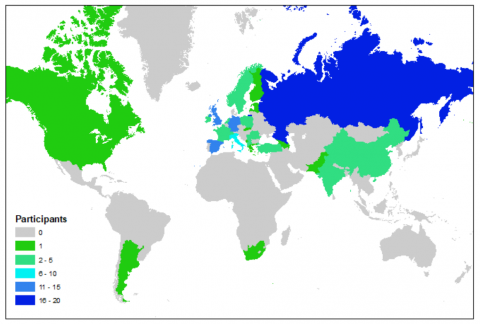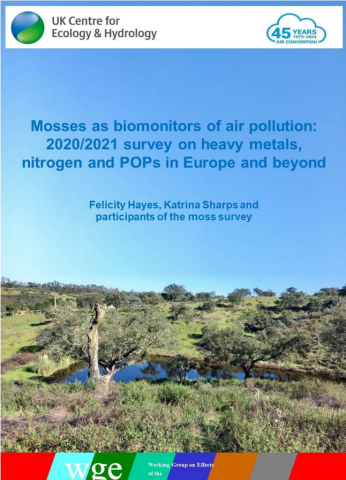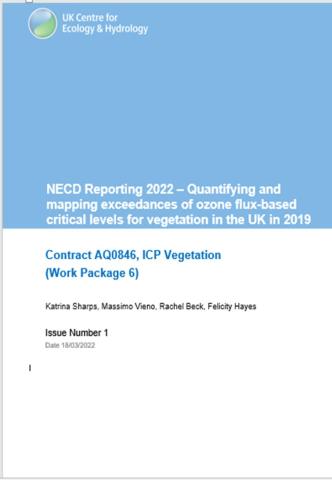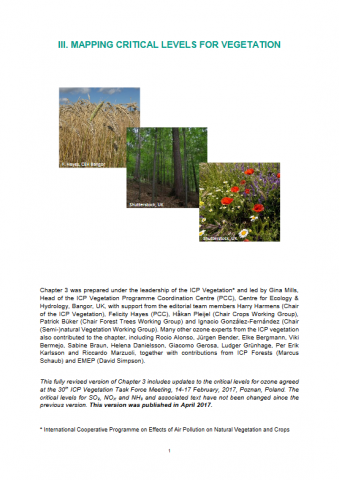
Distribution of countries, and number of participants per country, at the 34th, and first virtual, ICP Vegetation Task Force Meeting. Most of the meeting was run out of the chair’s (Felicity Hayes’) lounge, just a stone’s throw from her first ICP Vegetation meeting at Beaumaris, in 1999.
Blog by Mike Perring, Felicity Hayes, Josie Foster and Amanda Holder
Virtual meeting, 22nd to 24th February 2021.
Location online with chairing from Anglesey and Bangor, North Wales, UK.
The 34th ICP Vegetation Task Force Meeting was due to be held in Lithuania. As we are only too well aware, since the last annual meeting, COVID-19 has placed multiple spanners in multiple works. Circumstances necessitated a move from an in-person gathering to a virtual meeting, courtesy of the ICP Vegetation Co-ordination Centre at UKCEH, Bangor and Zoom. This wasn’t the only change, as Dr Felicity Hayes took over the chair from Dr Harry Harmens, participants could attend all sessions (rather than some parts being in parallel), and the meeting was shortened slightly to accommodate screen-fatigue. Nonetheless, the key ingredients remained: the meeting gave the opportunity for the latest research to be presented, achievements over the last year(s) to be aired, and future plans to be discussed. Participants were also able to take part in social chats in breakout rooms, while considering the talks and posters of the day.
125 people from 35 countries registered for the meeting, from China and the Russian Federation in the east, Canada and the United States of America in the west, Argentina and South Africa in the south, and the Scandinavian countries in the north. Around forty to eighty gathered at any one point in time in the virtual sphere from Monday afternoon to Wednesday evening (CET). They heard a varied collection of 32 talks, could inspect 15 posters and had the opportunity to ask questions and consider the direction of future research.
Plenary session – afternoon of 22nd February 2021
After a brief introduction to Anglesey, where the chair Felicity is located, the meeting started with a plenary talk from Christin Loran (Co-ordination Centre for Effects) and Alice James, who provided an update on the process for the review and revision of empirical critical loads for nitrogen in natural and near-natural ecosystems. They also presented the activities of the Centre for Dynamic Modelling, where there is welcome scope for interaction with the ICP Vegetation. This talk was followed by the Chair of the Working Group on Effects, Isaura Rabago, who gave a critical overview of recent developments in relation to the Air Convention and the upcoming revision of the Gothenburg Protocol. Isaura highlighted opportunities for action in the coming years, including looking at emerging issues of multiple stressors; ozone, nitrogen, climate change and biodiversity interactions; bridging across scales; and, monitoring and modelling critical loads for additional ecosystems. Felicity Hayes rounded the first half of the plenary session off with an overview of ICP Vegetation’s activities and achievements in the last year. These included contributions to Scientific Background Documents and empirical critical loads reviews, collaborations with the University of York on stomatal conductance – photosynthesis modelling in relation to ozone, and extension activities in to the tropics.
The second half of the plenary session picked up on the two main themes of the remainder of the meeting: the effects of ozone on vegetation accounting for other stressors, and pollution impacts on moss and lichens. First, Ignacio González-Fernández presented work on risk assessment from ozone at European- and plot-scales taking account of soil moisture when calculating the phytotoxic ozone dose (POD). This work highlighted a potential requirement to update the soil moisture indices that are used for calculating POD in different settings, and arguments to utilise species-specific parameterisations. Three talks then considered moss and lichen dynamics in different contexts: Marina Frontasyeva presented how moss surveying across Europe for environmental pollutants is proceeding well, despite the difficulties of COVID. Stefano Loppi considered how lichen biomonitoring and environmental justice are interlinked in Milan, Italy. He emphasized the role of brake dust, especially from trains, in determining bioaccumulation levels on lichens, and the relationships between pollutant exposure and socio-economic indicators. Finally, Julian Aherne discussed how microplastic deposition in urban environments can be quantified through moss biomonitoring. The latter two talks highlighted the use of active sampling, whereby biomonitoring material (lichen in the case of Stefano, moss for Julian) is transferred to particular sites relating to a likely gradient of interest. For instance, Julian highlighted the accumulation of microplastic fibres and fragments, and their relative contributions, across duplicate samples along a gradient of industrial, traffic and urban use in the greater Toronto area.
Participants then left for the day, giving people plenty of time to read up on the posters and book of abstracts for the next days. Indeed, given the circumstances of the meeting, posters were circulated ahead of time. Poster presenters were then available in break-out meeting rooms to answer questions on them at certain times on the Tuesday and Wednesday, while the talk sessions gave time for discussions on any of the themes raised.
Moss sessions – morning of 23rd and 24th February 2021
The moss session was split over two mornings. Talks and posters covered mosses as bioindicators of heavy metal air pollution, including the emerging issue of platinum group elements, polycyclic aromatic hydrocarbons / persistent organic pollutants, and microplastics, from across Europe, and beyond. The focus on metals also led to inclusion of talks on non-mosses. For instance, one poster and a related talk covered platinum and rare earth elements absorption by dandelion (Taraxacum officinale) in urban areas of Kosovo (Pristina) and Poland (Poznan).
COVID-19 made an appearance in the moss sessions. Contributors considered whether mosses can indicate short-term changes in air pollution, as opposed to the traditional role they play in passive bioaccumulation across multiple years. Moss image courtesy of Jan Dhiedt, virus from the CDC.
Common themes were the setting up of efficient yet informative monitoring networks, and the effectiveness of mosses as bioindicators of air quality. Much discussion went into the extension of activities to consider emerging air pollutant threats, such as microplastics, as well as the necessity to continue monitoring of heavy metals such as mercury and lead. One notable talk from Alexander Uzhinskiy went from assessment of current / recent past air quality through moss bioindication, to the prediction of pollution levels in unsampled areas, by combining the moss data with satellite imagery and machine learning. Quantifying the uncertainty associated with this (and other) approaches will be vital in the coming years, and is an important strand of future research. A COVID-19 theme was also present, with the atmospheric metal load considered by both Inga Zinicovscaia and D. Saxena, in Moscow and two cities in India respectively, in mosses before and during lockdown.
Ozone sessions – afternoon of 23rd and 24th February 2021
Like the moss sessions, talks on ozone were split over two days, this time in the afternoon, with topics covered including effects of multiple stressors (e.g. drought, nitrogen deposition) on crop biomass, the influence of genetic variation on responses to ozone (e.g. in wheat, in poplar), and developments in modelling e.g. incorporating nitrogen dynamics into the DO3SE model, and crop breeding. Talks also considered effects on organisms beyond plants, for instance how ozone affects those flower traits that influence pollinator attraction. The geographical scope of crop effects has also been widened beyond Europe, with Amanda Holder discussing ozone impacts on sweet potato, widely grown in sub-Saharan Africa. Five posters complemented the set of talks, in one case extending the geographical scope to subarctic biomes while returning to the theme of risk assessment, noted in the opening plenaries.
I
CP Vegetation includes outreach and extension amongst its official activities. Understanding the impact of rising ozone on key crop plants of developing nations, such as the sweet potato shown here, is one example of this outreach. Here, the impact of high ozone is clearly visible through injury and leaf loss, and it had consequences for yield (watch this space!)
Outcomes and next steps
As is usual, the meeting rounded off with discussions on the future workplan of ICP Vegetation. Atypically, this occurred through two ‘final’ discussions at the end of each of the second moss and ozone sessions. The programme schedule and abstracts can be found here. Keep watching the ICP Vegetation website for news on future developments.
This blog has concentrated a little more on the science, and less (than usual) on bringing the culture of the meeting location. Unfortunately, we did not have the opportunity to have a conference dinner, nor go for tours to interesting sights. We look forward to a new normal next year, where we will be able to reconvene in person in 2022 (perhaps with opportunities for remote connections too). Providing spanners have been removed from at least some works, the meeting will provisionally take place in Lithuania from 21st to 24th February 2022. For more information on the next Task Force Meeting, keep an eye on the ICP Vegetation website in the autumn of 2021.


